- Cost planning
- Cost Analysis
- Cost management Techniques
- Externally oriented Cost Management Techniques
- Relevant costs
- Short term decisions
- Risk and Uncertainty
- Linear programming – graphical method
- Linear programming the simplex method
- Multi Product CVP Analysis
- Pricing decisions and Pricing strategies
- Budgetary Control
- Performance Evaluation
- Measuring performance in divisionalised businesses
- Transfer pricing
Drawing a Basic Break-even Chart
A basic Break-even chart records costs and revenues on the vertical axis (y) and the level of activity on the horizontal axis (x). Lines are drawn on the chart to represent costs and sales revenue.
A break-even chart or graph shows:
- total costs, analyzed between variable costs and fixed costs
- sales
- profit (= the difference between total sales and total costs)
- the break-even point (where total costs = total sales revenue, and profit = 0).
The concept of a break-even chart is similar to a cost behavior chart, but with sales revenue shown as well. If the chart also indicates the budgeted volume of sales, the margin of safety can be shown as the difference between the budgeted volume and the break-even volume of sales.
The Break-even point can be read off where the total sales revenue line cuts the total cost line.

Drawing a Basic Profit/volume chart (P/V chart)
A profit volume chart (or P/V chart) is an alternative to a break-even chart for presenting CVP information. It is a chart that shows the profit or loss at all levels of output and sales. This chart plots a single line depicting the profit or loss at each level of activity.
The vertical axis shows profits and losses and the horizontal axis is drawn at zero profit or loss.
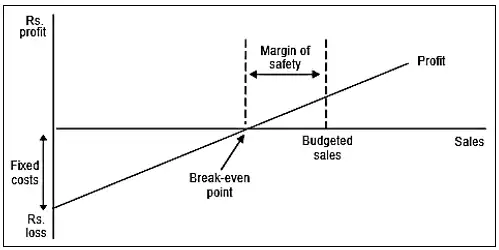
At Rs.0 sales, there is a loss equal to the total amount of fixed costs. The loss becomes smaller as sales volume increases, due to the higher contribution as sales volume increases. Break-even point is then reached and profits are made at sales volumes above the break-even point. The Break-even point is where this line cuts the horizontal axis.
Multi-product Break-even analysis
CVP Analysis assumes that, if a range of products is sold, sales will be in accordance with a pre-determined sales mix.
When a pre-determined sales mix is used, it can be depicted in the CVP Analysis by assuming average revenues and average variable costs for the given sales mix. However, the assumption has to be made that the sales mix remains constant. This is defined as the relative proportion of each product’s sale to total sales. It could be expressed as a ratio such as 2:3:5, or as a percentage as 20%, 30%, 50%.
This assumption allows us to calculate a weighted average contribution per unit or batch and/or CS ratio which can be used to solve Break-even, margin of safety and target profit problems.

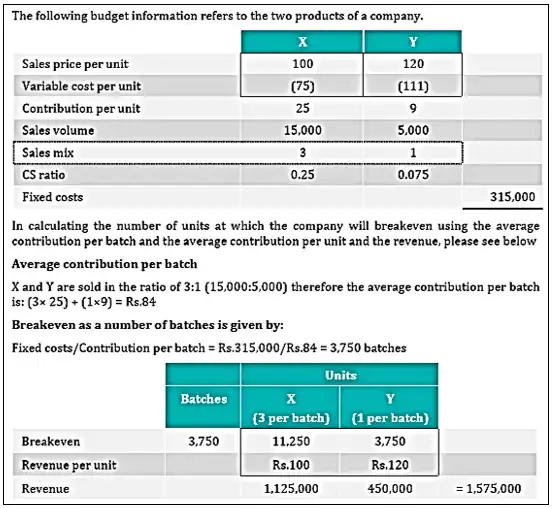
Break-even analysis – C/S ratio
In multi-product situations, a weighted average C/S ratio is calculated by using the formula:
Weighted average C/S ratio = Total contribution
Total revenue
The weighted average C/S ratio is useful in its own right, as it tells us what percentage each $ of sales revenue contributes towards fixed costs.
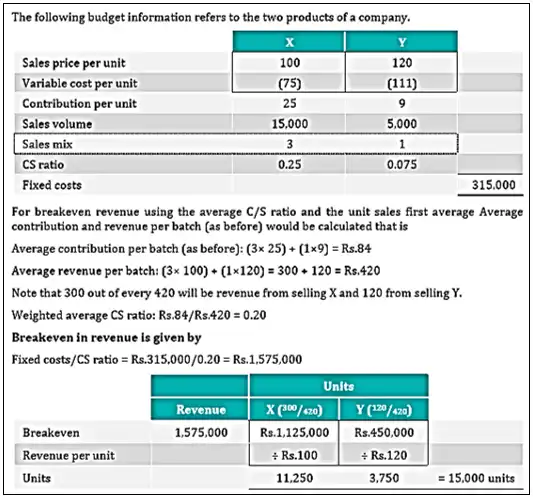
Margin of safety – Multi product
The margin of safety is the difference between:
- the budgeted sales (in units or Rs.) and
- the break-even amount of sales (in units or Rs.).
It is usually expressed as a percentage of the budgeted sales. However, it may also be measured as:
- a quantity of units (= the difference between the budgeted sales volume in units and the break-even sales volume), or
- an amount of sales revenue (= the difference between the budgeted sales revenue and the total sales revenue required to break even).
It is called the margin of safety because it is the maximum amount by which actual sales can be lower than budgeted sales without incurring a loss for the period. A high margin of safety therefore indicates a low risk of making a loss.
For Multi-product margin of safety, the break-even point can be compared to the budgeted activity level using batches, units or revenue.
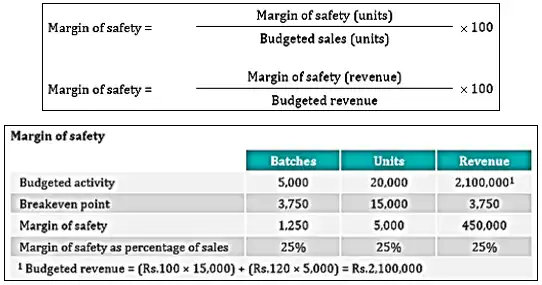
Establishing a target profit for multiple products
Management might want to know what the volume of sales must be in order to achieve a target profit. CVP analysis can be used to calculate the volume of sales required.
The necessary contribution to earn the target profit is the target profit plus the fixed costs. The activity level required to achieve the necessary contribution may be found using contribution per unit, contribution per batch or the CS ratio.
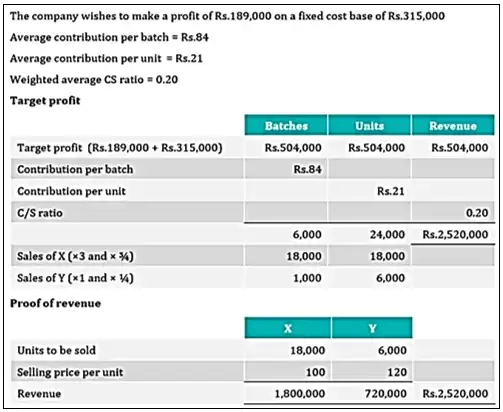
Advantages of Break – Even Analysis
- The major benefit of using Break-even analysis is that it indicates the lowest amount of activity necessary to prevent losses.
- Break-even analysis aids Decision Marking as it explains the relationship between cost, production volume and returns.
- It can be extended to show how changes in fixed costs – variable costs relationships or in revenues will affect profit levels and Break-even points.
Limitations of break-even analysis
The following underlying assumptions will limit the precision and reliability of a given cost-volume-profit analysis.
- The behaviour of total cost and total revenue has been reliably determined and is linear over the relevant range.
- All costs can be divided into fixed and variable elements.
- Total fixed costs remain constant over the relevant volume range of the CVP analysis.
- Total variable costs are directly proportional to volume over the relevant range.
- Selling prices are to be unchanged.
